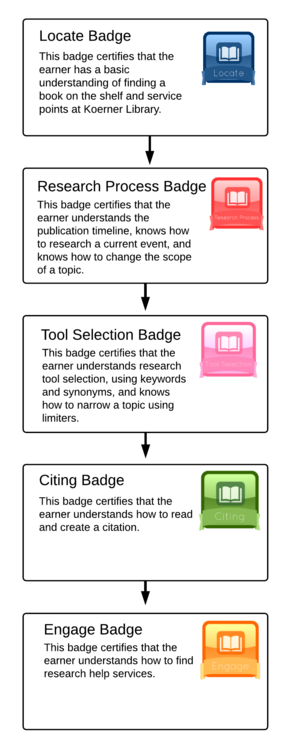Documentation:Open Badges/Plan/Touchpoints
Touchpoints refer to your first considerations around criteria for the badge. Touchpoints must be considered in conjunction with badge issuing. The badge issuing determines how the badge will be awarded using the technology provided. There may be some constraints in how you offer your badge as not all badge issuing can be automated. For example, a badge can be issued when a blog post shows critical evaluation of an article but someone will need to review the post and issue the badge.
Leveled Badge Systems
Does the badge earner need previous skills or knowledge to earn a badge?
In addition to deciding on the types of badges you will issue, you need to consider whether to use badge levels. Badge levels is the structure or path in which badges are earned. Decisions about using badge levels depend on whether there is a hierarchy in the learning process that requires an earner to gain specific knowledge and/or skill before moving on. Badges levels can also be useful if a topic is complex enough that it needs to be broken down into sub-themes and competencies.
The following outlines the kinds of leveled badge systems that should be considered when designing a badge pathway.
Tiered Badges
Tiered badges place badges in an explicit hierarchy. The purpose of a tiered system may be the following:
- A student needs prior knowledge, skills, and/or behaviours before moving on to more complex material
- An instructor may want to track the progress through a topic by badge-specific milestones
A tiered system of badges can concentrate the efforts of badge earners on one topic, which deepens their knowledge as they move through content.

The Videographer badge requires increasing mastery of the subject before learning more complex skills.
Meta-level Badges
Meta-level badges represent several skills, behaviours, knowledge, and/or abilities that make up a higher level of understand around a larger topic. The type of learning here does not necessarily need to be hierarchical like with the tiered badge design. The purpose of meta-level badges is to identify the core competencies in a subtopic of a larger area of study. The purpose of a meta-level badge system may be the following:
- An instructor may want to scaffold a complicated topic by breaking it down into more manageable subtopics
- An instructor may want to target specific topics to signal mastery of a complex skill set

Web design skills require an understanding of basic design principles. These badge are meta-literacies that make a Design Principles badge for web designers.
Examples of Leveled Badge Systems
Badge Earning Criteria
What will learners need to do in order to get the badge?
The activity required for a student to earn a badges is important to consider seriously. For badges to hold real value and to carry authority, assessment and quality is critical. Badges can contain multiple levels of assessment, depending on the use case, community or intended audience. Some require distinct predefined assessment exercises and success criteria while others may be loosely defined and require earner reflection or peer recommendations.
Consider the perspective of both the earner and the issuer when developing badge criteria.
For badge earners:
- Is the badge sufficiently challenging for the skill or knowledge level of the badge earner?
- Alternately, is the badge too challenging for the badge earner?
- Will the badge help the badge earner get a job?
For badge issuers:
- Hard skills can require standard or more rigid rubrics to compare learner work against.
- Softer skills can be more fluid and require more open and social assessments like peer reviews or endorsements.
- For certification badges, intended for audiences like hiring managers, admission boards, more rigorous assessments can be required.
- For badges intended to simply build community or reward behaviors, simple assessments may be sufficient.
Examples of Badge Touchpoints
Getting Started
To plan the touchpoints of your badge learning pathway, consider how your badges connect with one another. That is, think about the order in which badges will be earned and answer the following questions.
|
|



